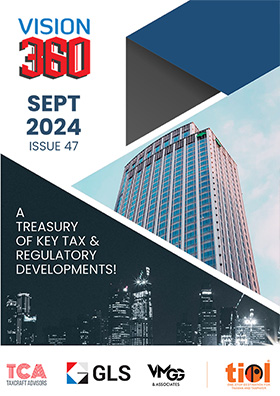Income tax - Whether when STPI has granted separate registrations, three EoUs cannot be treated as Single Unit merely because they have not maintained separate books - YES: ITAT
By TIOL News Service
NEW DELHI, JUNE 02, 2015: THE issue before the Bench is - Whether when STPI has granted separate registrations, the three EoUs cannot be treated as Single Unit merely because they have not maintained separate books. YES is the answer.
Facts of the case
A) The assessee filed a return of income declaring loss. Later on, the case was selected for scrutiny. During the course of assessment proceedings the AO noticed that the assessee had 3 independent and separate 100% Export Oriented Undertaking (EOU) which were engaged in the same line of business and no separate books of accounts had been maintained for these units so these were in fact expansion of the same business. The AO also raised the doubt about the allocation of expenses to these units to arrive at the conclusion that deduction could not be calculated in respect of the units separately. He, therefore, calculated the deduction u/s 10B of the Act by aggregating all the profits of the eligible or non-eligible units by applying the formula as given in section 10B(4) of the Act to the entire profits of the business of the assessee company.
In appeal, CIT(A) observed that it was not the case of the AO that the three eligible units had been formed by splitting up or reconstructing the old or non-eligible units and since there were enough evidence in the assessee's case that the three Export Oriented Units were formed independently of the existing units for the purpose of export of software and those were approved as such by the relevant authorities and they had been functioning independently of each other for the purposes of business of export of software, therefore, those units have to be treated as eligible undertakings for the purposes of deduction u/s 10B of the Act and the profits arising there from have to be allowed as deduction under that section separately as certified by the Audit Report in Form 56G. CIT(A) directed the AO to recomputed the deduction u/s 10B of the Act by considering each unit as separate for claiming deduction u/s 10B of the Act.
B) During the course of assessment proceedings, AO observed that all the three different units of the assessee were not operating in isolation as claimed and it was only for the purpose of computing deduction u/s 10B of the Act that the assessee tried to allocate the expenses between various units for computing deduction under the said section and that the profits of the units eligible for deduction u/s 10B of the Act were disproportionately high as compared to the total business of the assessee. He, further observed that the assessee did not maintain separate books of accounts for all the units and also did not give the basis of apportionment of common expenses, therefore, the deduction u/s 10B of the Act was to be computed by apportioning the aggregate profits of the assessee from all the business including the domestic business in the ratio of export turnover to the total turnover. The AO also held that the assessee wrongly computed unabsorbed depreciation brought forward from the earlier assessment year. According to the AO, the assessee had been wrongly computed unabsorbed depreciation in the earlier years by first claiming deduction u/s 10B of the Act, while computing income under the head profits and gains of business or profession and not out of the gross total income, after adjusting unabsorbed depreciation, if any, carry forward from earlier years. The AO also observed that in case there was any unabsorbed depreciation relating to the earlier assessment years which was found to be allowable to the assessee, such unabsorbed depreciation had to be first reduced from the eligible profits before allowing deduction u/s 10B of the Act and the deduction under the said section was to be restricted to the extent of residual profits of the business.
In appeal, CIT(A) held that there was no brought forward unabsorbed depreciation in respect of 100% EOUs and the unabsorbed depreciation was in respect of non-eligible business which the AO had deducted from the profits of the entire business while allowing deduction u/s 10B of the Act. CIT(A) held that deduction u/s 10B of the Act was allowable at the source itself and not after computation of gross total income. The CIT(A) directed the AO to allow the deduction u/s 10B of the Act from the profit of the eligible undertaking without setting off the losses or unabsorbed brought forward depreciation.
C) Revenue submitted that the assessee did not furnish the evidences before the AO in the course of assessment proceedings, therefore, the CIT(A) was not justified in admitting the additional evidences.
Having heard the parties, the tribunal held that,
A) ++ AO treated the three Export Oriented Undertaking of the assessee as a single unit, only on this basis that separate books of accounts were not maintained, on the contrary, each of the three undertakings had been separately and independently granted registration by Software Technology Park of India, Pune (STPI) for claiming exemption u/s 10B of the act as newly set up 100% EOU. Those three units were also granted separate licence by the Customs Authorities. Those EOU's were situated at separate location having independent buildings on separate addresses, their Plant & Machinery and fixed assets were also separate and each of the EOU furnished separate Audit Report in Form No. 56G. Therefore, it cannot be said that the three EOU's of the assessee company were formed after splitting off of the existing unit or reconstructing the old or non-eligible unit. In the present case, although it is an admitted fact that these units were not having separate books of accounts but ERP software accounting system was implemented by each of them and transactions of each unit were separately coded all the transaction were identifiable as in the case of separate books. Therefore, the CIT(A) was fully justified in directing the AO to compute the deduction u/s 10B of the Act in respect of each unit separately;
B) ++ Assessee was not having any unabsorbed depreciation relating to the eligible Export Oriented Units (EOU's). Therefore, adjustment in the eligible profits of the EOU was not to be made on account of brought forward unabsorbed depreciation. The said unabsorbed depreciation was adjusted by the assessee against certain income from other sources and not against the eligible profits of the 100% EOU;
++ Karnataka High Court in the case of CIT Vs Yokogawa India Ltd. 2011-TIOL-711-HC-KAR-IT held that as the profits and gains under section 10A were not to be included in the income of the assessee at all, the question of setting off the loss of the assessee from any business against such profits and gains of the undertaking would not arise. Similarly, as per section 72(2), unabsorbed business loss is to be first set off and thereafter unabsorbed depreciation treated as current year's depreciation under section 32(2) is to be set off. As the deduction under section 10A has to be excluded from the total income of the assessee, the question of unabsorbed business loss being set off against such profit and gains of the undertaking would not arise;
++ High Court in the case of CIT Vs TEI Technologies Pvt. Ltd. 2012-TIOL-691-HC-DEL-IT held that for computing deduction under section 10A in respect of an export processing zone unit, the losses suffered in the non-export processing zone unit need not be set off against the profits/income of the export processing zone unit. The brought forward losses of the non-export processing zone unit need not be deducted or reduced;
++ therefore, impugned order of CIT(A) upheld;
C) ++ AO vide notice u/s 142(1) of the Act called the details relating to claim u/s 10B of the Act which the assessee furnished. The CIT(A) found from the record that the assessee replied to the showcause regarding the allowability of deduction u/s 10B of the Act vide submissions dated 30.12.2009. The CIT(A) categorically stated that there was no specific show-cause given to the assessee as to why all the units of the assessee company be not treated as a single unit for the purpose of allowance of deduction u/s 10B of the Act, therefore, specific opportunity was not granted to the assessee for clarifying the issue as to why all the units of the assessee may not be considered as one unit for the purpose of section 10B of the Act and that the documents furnished by the assessee before him goes to the route of the aforesaid issue relating to deduction u/s 10B of the Act. In the present case, the CIT(A) admitted those evidences after providing due and reasonable opportunity to the AO who furnished his remand report. Therefore, there is no merit in this ground of the departmental appeal.
(See 2015-TIOL-623-ITAT-DEL)















